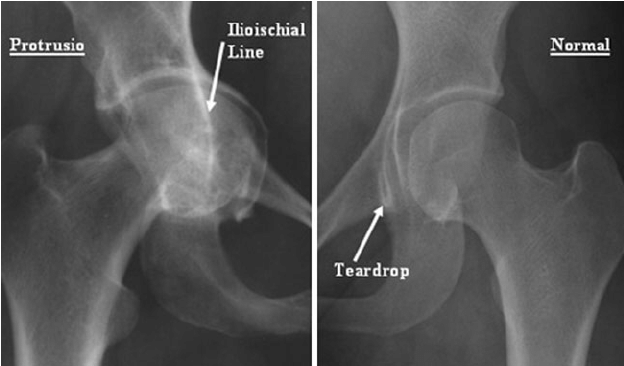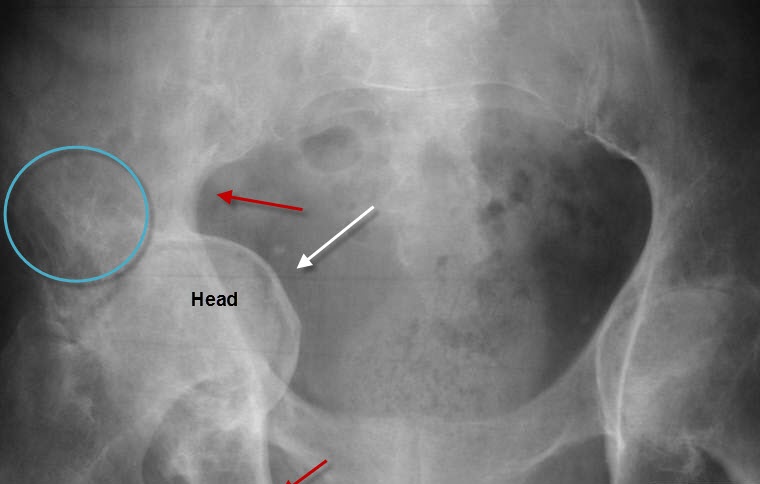Protrusio Acetabulum
Protrusio acetabuli is a rare anatomic pattern of the hip in which the femoral head protrudes into the true pelvis. Protrusio acetabuli (arthrokatadysis or Otto pelvis) is a relatively rare condition associated with secondary osteoarthritis of the hip. Radiographically, protrusio acetabuli is present when the medial aspect of the femoral head projects medial to Kohler’s (ilioischial) line. This results in medialization of the center of rotation (COR) of the hip. Protrusio acetabuli is typically associated with metabolic bone disease (osteoporosis, osteomalacia, Paget’s disease) or inflammatory arthritis (RA or ankylosing spondylitis). Idiopathic acetabular protrusio can occur without the above associated factors however. Patients with protrusio acetabuli typically present with significant restriction of range of motion (ROM) of the hip due to femoral neck and trochanteric impingement in the deep acetabular socket and pain associated with secondary osteoarthritis (OA).
Protrusio acetabuli
Includes the most common causes
P: Paget disease
R: rheumatoid arthritis (and other arthritis such as osteoarthritis, ankylosing spondylitis, juvenile idiopathic arthritis, crystal arthropathy)
O: osteomalacia, osteogenesis imperfecta
T: trauma

My PROTRUSIO
The complete list:
My: Marfan syndrome
P: Paget disease or primary protrusio acetabuli
R: rheumatoid arthritis
O: osteogenesis imperfecta
T: trauma (or tumor locally / tumor causing osteomalacia: rare)
R: rickets
U: unknown (idiopathic)
S: (p)soriatic arthritis (or sickle cell anemia: rare)
I: inflammatory arthritis (ankylosing spondylitis) (or infection: rare)
O: osteomalacia

medlight2u.com
Acne Acne vulgaris Acute Renal Failure Adrenal cortex Angina Angina Pectoris Aortic Regurgitation (AR) Aortic Stenosis (AS) Chest pain Chronic pyelonephritis Coarctation of Aorta Cough cyanosis Cystic acne Dehydration depression Diabetes Mellitus Diagnosis of Aortic Stenosis Dr.KTS DR K TAMILSELVAN Fatigue Heart Failure Hypertension Hypokalemia Hypothyroidism Ischemic Heart Disease LBBB Mitral Incompetence Mitral insufficiency Mitral valve prolapse Nocturia Patent Ductus Arteriosus PDA Polyuria Proteinuria pulmonary hypertension Pulmonary Stenosis ST Depression Symptoms of Acne Syncope Treatment for acne valvular heart disease Ventricular Septal Defect VSD Zits


Leave a Reply